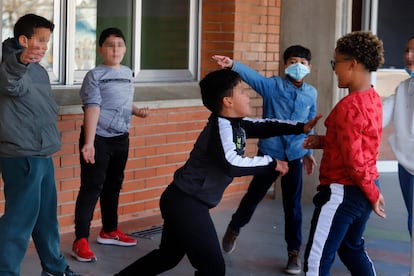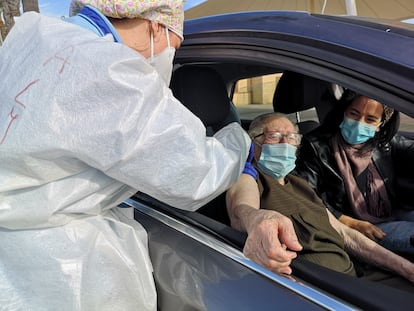Masks in schools are not associated with lower coronavirus transmission, says new study
The Spanish researchers found that there were no significant differences in transmission between the over-sixes, who must wear face-coverings, and the under-sixes, who are exempt from the rule


The use of face masks in schools has not been a determining factor for containing the spread of the coronavirus. They may have had an effect, but they have not been key to stopping contagion. That’s the conclusion of a study led by Catalan researchers after analyzing the first semester of the 2021-22 academic year in the region.
In Spain, it is still obligatory for children aged six and over to wear a face mask in class. But scientists have not found that neither the incidence rate nor the transmission of the virus was significantly lower among these groups compared to the under-sixes, who do not have to wear the coverings. The researchers stress, however, that the results of this work – which is yet to be peer-reviewed or published in a scientific review – cannot be extrapolated to other environments, such as a cinema or shopping mall.
Clara Prats, a physicist and researcher from the Catalonia Polytechnic University, stresses that the study “is not analyzing the effectiveness or otherwise of masks, but rather their implementation in a very specific environment: schools.”
The study, she continues, “analyzed the first semester of the academic year, a time when testing was carried out on classmates every time there was a positive case. We could see the transmission that there was in each age group. If the implementation of masks had a significant effect on transmission, we would have found less transmission in the first year of elementary [six year olds] than in P5 [the year below in infants’ school]. But there were no differences between these two years,” she concludes.
This is not to say that masks have not worked, adds Quique Bassat, a pediatrician and epidemiologist from the ISGlobal health institute. “Masks offer protection, but in young children, aged from three to 11, where transmission is lower and risk attitudes are different to those of teenagers, the impact of this measure is more modest.”
Prats points to a number of factors that influence the greater or lesser efficiency of masks in schools, such as the “time factor,” for example, children spend a lot of hours in the classroom, and as time passes the protection offered by a mask falls. The masks used by children, meanwhile, tend to be cloth or surgical face coverings. These do not perfectly fit over the nose and mouth, meaning the risk that virus-laden aerosols escape is greater – this is particularly significant in a context of a more-contagious variant such as omicron.
Relaxation of measures
The determining factor that influences a greater or lesser transmission of the virus is age, Prats insists. “The incidence and transmission rise gradually the greater the age,” she explains. To justify the weight of this variable, experts point to the role that the reduction of the innate immunological response has as the years go by, and a change toward an immunological response pattern that is similar to those of adults as a child progresses through elementary school.
In the current context where measures are being relaxed in Spain – face masks are no longer required in schoolyards, for example – and with the removal of their use indoors just a matter of time ago, this new Catalan study backs the theory that the Spanish Pediatric Association also defended, when it called several weeks ago for face coverings in classrooms to be removed. “The conclusions cannot be extrapolated to other environments, but they do suggest that the removal of mask use in elementary schools should not mean a significant rise in transmission,” Prats explains.
Soriano says that, with the evidence in hand, “it makes no sense” to continue with mask use in schools. “It would leave a very bad taste in my mouth if we didn’t remove masks for children and in interior spaces for everyone else all at the same time.”
Tu suscripción se está usando en otro dispositivo
¿Quieres añadir otro usuario a tu suscripción?
Si continúas leyendo en este dispositivo, no se podrá leer en el otro.
FlechaTu suscripción se está usando en otro dispositivo y solo puedes acceder a EL PAÍS desde un dispositivo a la vez.
Si quieres compartir tu cuenta, cambia tu suscripción a la modalidad Premium, así podrás añadir otro usuario. Cada uno accederá con su propia cuenta de email, lo que os permitirá personalizar vuestra experiencia en EL PAÍS.
¿Tienes una suscripción de empresa? Accede aquí para contratar más cuentas.
En el caso de no saber quién está usando tu cuenta, te recomendamos cambiar tu contraseña aquí.
Si decides continuar compartiendo tu cuenta, este mensaje se mostrará en tu dispositivo y en el de la otra persona que está usando tu cuenta de forma indefinida, afectando a tu experiencia de lectura. Puedes consultar aquí los términos y condiciones de la suscripción digital.
More information
Últimas noticias
Most viewed
- David King, chemist: ‘There are scientists studying how to cool the planet; nobody should stop these experiments from happening’
- Mexico completes its trade shift with the entry into force of tariffs on China and countries without trade agreements
- Reinhard Genzel, Nobel laureate in physics: ‘One-minute videos will never give you the truth’
- Oona Chaplin: ‘I told James Cameron that I was living in a treehouse and starting a permaculture project with a friend’
- Sinaloa Cartel war is taking its toll on Los Chapitos










































